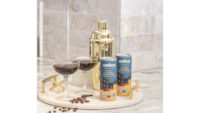To Sip, Perhaps not to Spill

To Sip, Perhaps not to Spill
Dan McGrath’s niece and nephew were leaving the bottle for the sippy cup, and his sister-in-law had nothing but complaints.
Parents of toddlers will recognize those familiar
refrains: After a few rounds in the dishwasher, the silicon inserts used to
control the flow stopped fitting properly, turning the sippy cup into a
spilling cup. Milk and juice spilled everywhere.
When disposable cups became available, McGrath got an
idea. McGrath, the president of Churchill Beverage whose family owned Epic
Food Marketing in Houston, saw an opportunity to create pre-filled
single-serve aseptic sippy cups. SippyTips use a semi-rigid form and have a
protective cap and pull strip over the spout and air intake, which preserve
the integrity of the product until consumption. SippyTips can be used for
both 6- to 8-ounce packages of milk and juice.
He now holds a patent on SippyTips, and says that a
“major regional dairy company” will roll these out next year.
The suggested retail price is $1 to $1.50 for a three-pack wrap.
“It was an obvious jumping-off point,”
McGrath says of sippy cups, which he describes as “ubiquitous and the
bottle of choice for 1 to 4 year olds.
“What we’ve developed is a practical
methodology that brings down the investment in aseptic beverage equipment
lines by over 50 percent using current technology. At the same time we are
introducing consumer packaging designs that optimize convenience and safety
that actually plays into the consumers’ habitual associations with
existing, traditional packaging formats,” McGrath says.
“SippyTips will be our first product to market, an innovative,
pre-filled, single-serve aseptic sippy-style cup that targets the 9-month
to 4-year-old demographic, who by no coincidence have some of the highest
consumption rates of fluid milk and juices.”
McGrath says he seized on the trend toward aseptic.
“There is a greater reduction of food pathogens,” McGrath says,
adding that foodservice would benefit from the SippyTips because a
restaurant worker can grab one off the shelf and know that it’s fresh
and hasn’t been breached.
This packaging has a lower barrier of entry to the
market, McGrath says, by reducing the cost of machinery. SippyTips
don’t require a form/fill/seal machine, but combine two technologies
into one by using thermoformed plastics combined with a retort process.
“It takes the bulk cups and separates them individually on the line,
then uses a fill/seal/cap process,” he says. “It lowers capital
expenditures by 75 percent.”
McGrath believes that dairy trade associations should
be educating the consumer on the benefits of aseptic milk, which he insists
should be sold in the dairy case rather than relegated to the dry goods
shelf. “I will not be satisfied,” he says, “until
the milk board launches a TV ad during the Super Bowl that announces,
‘got aseptic?’”
Looking for a reprint of this article?
From high-res PDFs to custom plaques, order your copy today!





